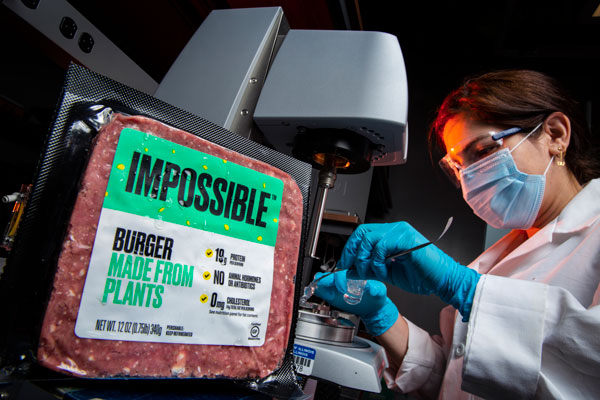Bite, Crumble, Chew
Engineers take the meat out of the burger
By David Brazy
t

A few decades ago, plant-based “meat” and “milk” that looked and tasted just like the real thing seemed like science fiction. The names of today’s most popular brands of plant-based food—Impossible Foods, Beyond Meat, Before the Butcher—still reflect these mythical origins.
But food scientists and chemical engineers have been pushing plant-based food past what was once thought within reach, opening a new way for consumers to avoid eating animals, reduce their carbon footprints, and eat healthier.
One of the scientists working to perfect non-animal substitutes is Vivek Sharma, an associate professor of chemical engineering at UIC. He recently began a two-year partnership with the Boston-based company Motif FoodWorks and several other universities to improve how plant-based foods feel when we bite into them.
Anyone who has taken a bite out of a perfectly cooked burger that seemed to melt into their mouth or pulled out the first slice of pizza and watched the melted cheese stretch knows the importance of the look and feel of our food.
t
If I am going to consume a piece of alternative meat or cheese made with plant-based proteins, unless I feel like I’m chewing something that resembles the real thing, despite how good the flavor is, I’m not going to get the same satisfaction.
| Associate professor of chemical engineering
t
That’s where Sharma and the scientists in his Soft Matter ODES Lab come in. They specialize in using chemical and molecular engineering to understand the flow behavior—formally called rheology—of a wide range of substances, including foods, cosmetics, and pharmaceuticals. When it comes to foods, Sharma and his colleagues also are experts in how we process them and perceive their texture.
Sharma’s research seeks to describe and measure the rheology and processability of complex fluids and other soft materials that don’t behave like “simple” Newtonian fluids, such as water or glycerol.
For example, Sharma said, everyone knows that cheese is supposed to be stringy, but you cannot measure that characteristic in the same way you could measure the cheese’s weight, volume, or density.
“Our claim to fame is that we develop new techniques that allow us to get quantitative measurements of rheological response, as well as of heuristic material properties such as sprayablility, stringiness, stickiness, ropiness, and spinnability,” he said. Measurements like these are key to mass-producing plant-based burgers, cheeses, and yogurts that need to taste and feel the same every time.
Motif FoodWorks is working with faculty members at other universities on this initiative as well, including the University of Illinois at Urbana-Champaign, University of Queensland, University of Guelph, and University of Massachusetts Amherst. Sharma noted that the company selected scientists and researchers who have a deep interest in developing both characterization methods and an understanding of how certain ingredients affect food-based materials.
The academic-industry partnership comes as the popularity of plant-based foods grows around the world. Data released this spring by SPINS, a company that tracks retail sales information, show that global grocery sales of plant-based foods that directly replace animal products have increased 29 percent in the past two years, to $5 billion. These trends are not expected to change: the market-research firm Global Market Insights projects that the plant-based meat market in the United States alone will reach $4.15 billion by 2026.
Shayna Oshita, a registered dietitian and clinical assistant professor in kinesiology and nutrition at UIC, has seen a slow but steady upward trend in the popularity of plant-based foods since the Mad Cow disease scare of the early 2000s. Awareness seems to have exploded when national fast-food chains started offering plant-based burgers across the country, she said.
Oshita noted that her clients have different reasons for wanting to experiment with or switch over to plant-based foods. A popular reason she hears is that people want to cut out red meat from their diets. Others are concerned about the food industry’s treatment of animals, climate change, reducing their carbon impact, or overall sustainability. One overlooked benefit of plant-based foods, she said, is they are often safer than their meat or dairy versions because they do not carry as high a risk of E. coli or salmonella.
Sharma said his initial partnership with Motif is focused on investigating model future foods and developing techniques that can be used to transform the plant-based food industry. But he and his collaborators have their eyes on larger goals down the line.
“The industry-academia collaboration and coordinated effort among different teams will allow us to tackle the big challenges of making plant-based foods more accessible, healthier, tastier, and cheaper,” Sharma said. “This is incredibly important because these plant-based foods will be needed in the future due to population growth, and we only have so much land and other resources available for food production.”
To get there, a lot of work still needs to be done in labs and kitchens across the country. For Sharma, this prospect is exciting and allows him to use his knowledge and expertise to help improve foods’ rheology, texture, and processing. At the end of the day, if all of those parts fit together, people will be able to enjoy a plant-based burger that tastes great, is juicy, crumbles in the mouth, and is healthy and sustainable for the planet.
Sharma likened the research process to how a person’s favorite song is put together.
“When fans listen to the song, they don’t know how every note was written, or how much the guitarist or the drummer practiced to perfect it. But they don’t need to know,” he said. “The only way you can say a song is great is if you listen to it and enjoy it.”
“It’s the same way with plant-based food. We need to optimize every ingredient for flow behavior and mouthfeel until the finale is a masterpiece. Each one of us is trying to solve a small piece of the scientific puzzle.”